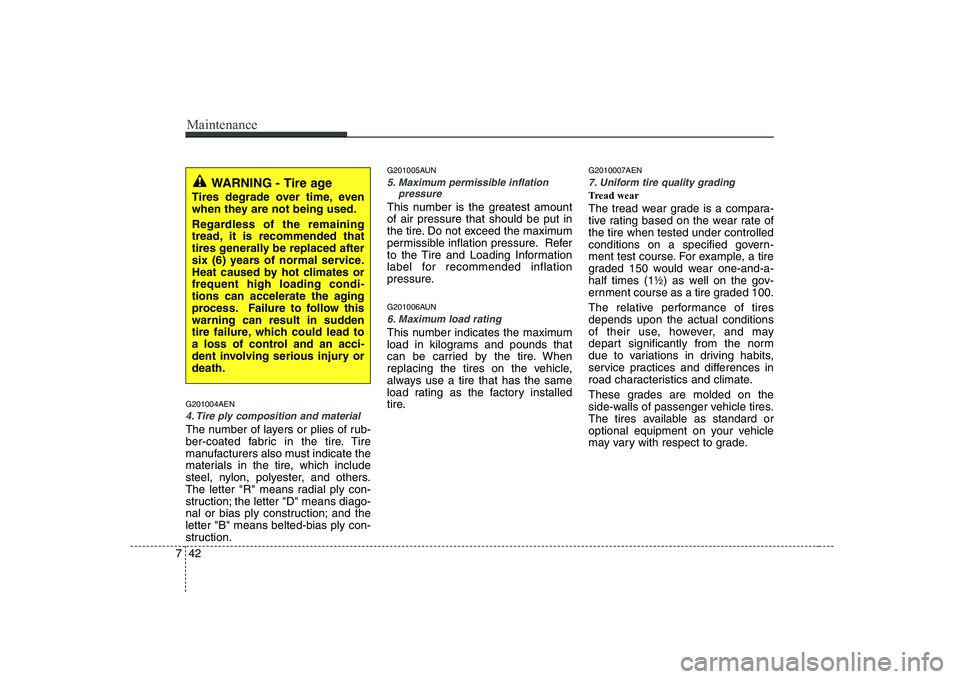Page 292 of 332

Maintenance
42
7
G201004AEN
4. Tire ply composition and material
The number of layers or plies of rub-
ber-coated fabric in the tire. Tire
manufacturers also must indicate the
materials in the tire, which include
steel, nylon, polyester, and others.
The letter "R" means radial ply con-
struction; the letter "D" means diago-
nal or bias ply construction; and theletter "B" means belted-bias ply con-
struction. G201005AUN
5. Maximum permissible inflation
pressure
This number is the greatest amount of air pressure that should be put in
the tire. Do not exceed the maximum
permissible inflation pressure. Refer
to the Tire and Loading Information
label for recommended inflation
pressure.
G201006AUN
6. Maximum load rating
This number indicates the maximum
load in kilograms and pounds that
can be carried by the tire. When
replacing the tires on the vehicle,
always use a tire that has the same
load rating as the factory installed
tire. G2010007AEN
7. Uniform tire quality grading
Tread wear
The tread wear grade is a compara-
tive rating based on the wear rate ofthe tire when tested under controlled
conditions on a specified govern-
ment test course. For example, a tire
graded 150 would wear one-and-a-
half times (1½) as well on the gov-
ernment course as a tire graded 100.
The relative performance of tires depends upon the actual conditions
of their use, however, and may
depart significantly from the norm
due to variations in driving habits,
service practices and differences in
road characteristics and climate.
These grades are molded on the
side-walls of passenger vehicle tires.
The tires available as standard or
optional equipment on your vehicle
may vary with respect to grade.
WARNING - Tire age
Tires degrade over time, even
when they are not being used.
Regardless of the remaining
tread, it is recommended that
tires generally be replaced after
six (6) years of normal service.
Heat caused by hot climates orfrequent high loading condi-
tions can accelerate the aging
process. Failure to follow this
warning can result in sudden
tire failure, which could lead to
a loss of control and an acci-
dent involving serious injury ordeath.
Page 319 of 332
8
Dimensions / 8-2 Bulb wattage / 8-2
Tires and wheels / 8-3Recommended lubricants and capacities / 8-4
Vehicle identification number (VIN) / 8-6
Vehicle certification label / 8-6
Tire specification and pressure label / 8-7
Engine number / 8-7
Specifications & Consumer information
Page 321 of 332
83
Specifications & Consumer information
TIRES AND WHEELS
I020000ABH
Inflation pressure bar (psi, kPa)
Front Rear
225/45R18 7.5J×18 24 (35, 240) -
245/45R18 7.5J×18 - 24 (35,240)
225/40R19 8.0J×19 24 (35, 240) -
245/40R19 8.5J×19 - 24 (35, 240)
T135/90D17 4.0T×17 42 (60, 420) 42 (60, 420)
T135/80R18 4.0T×18
Full size tire
Compact
spare tire Wheel lug nut torque
9~11
(65~79 , 88~107)
Item
Tire
size Wheel size
Page 325 of 332
87
Specifications & Consumer information
TIRE SPECIFICATION AND PRESSURE LABEL
H030000AUN
The tires supplied on your new vehicle
are chosen to provide the best perform-
ance for normal driving.
The tire label located on the driver's side
center pillar gives the tire pressures rec-
ommended for your car.ENGINE NUMBER
H04000AUN
The engine number is stamped on the
engine block as shown in the drawing.
OBK089003
OBK089004
3.8L
2.0 TCI
OBK089005